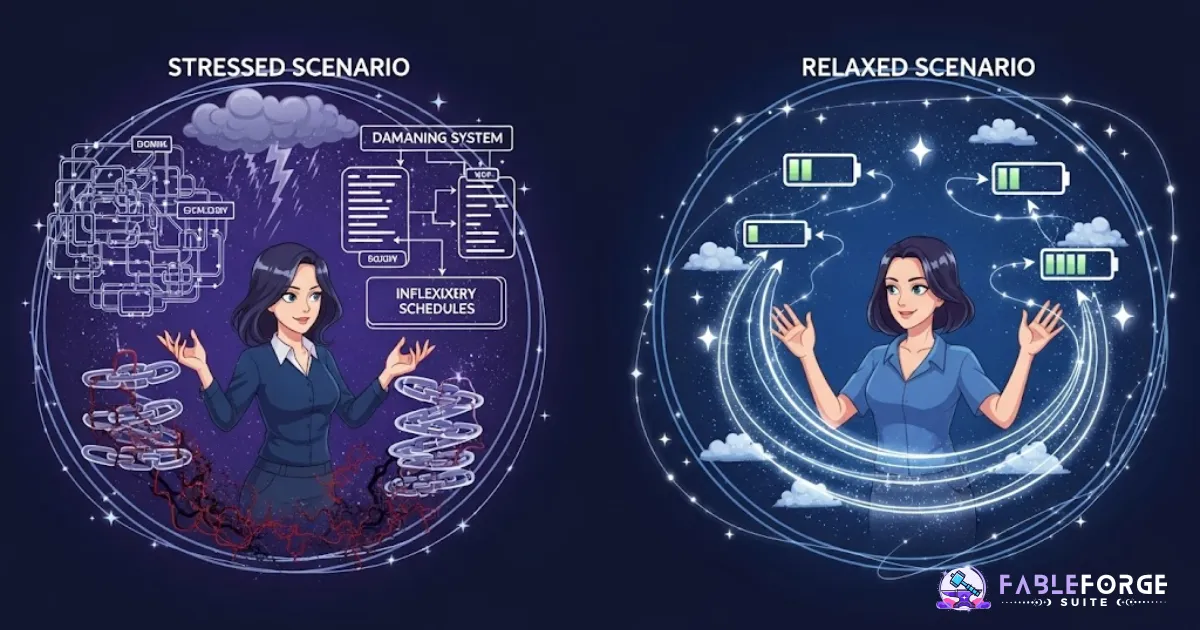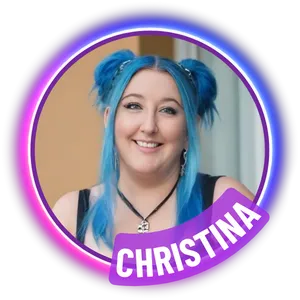
How to Build Business Systems That Work When You're Tired (A Guide for Real Humans)
Most business advice assumes you have consistent energy and executive function. Here's how to build systems for your actual life—including periods, ADHD brain fog, chronic illness, and all the other realities that "productivity gurus" pretend don't exist.
Let me tell you about Alex, who designed the "perfect" content creation system:
Batch content every Sunday for 3 hours
Schedule social media posts for the entire week
Write newsletter on Monday morning when creative energy is highest
Update CRM notes immediately after every client call
Review analytics every Friday afternoon
This system looked amazing on paper. It was efficient, organized, and completely optimized.
In real life? Alex managed to stick with it for exactly 2.5 weeks before it completely fell apart.
Why? Because the system was designed for the version of Alex who never gets sick, never has ADHD brain fog days, never feels overwhelmed by client work, never has periods of low motivation, and always has predictable energy levels.
That version of Alex doesn't exist.
The Perfectionist System Trap
Most entrepreneurs fall into this exact trap. They design systems for their ideal selves instead of their real selves.
The ideal self:
Has consistent energy every day
Never gets distracted or overwhelmed
Remembers to do everything at the optimal time
Maintains motivation through all seasons of life
Has predictable capacity and focus
The real self:
Has energy that fluctuates with hormones, sleep, stress, and health
Sometimes can't focus for more than 10 minutes
Forgets things regularly (even important things)
Goes through periods of high and low motivation
Deals with periods, illness, family chaos, and life disruptions
The problem: When we build systems for ideal-self, real-self fails constantly and feels broken.
Your Brain on Business Systems: The Reality
Let's get honest about how our brains actually work:
🧠 Energy is Variable
Some days you're sharp and focused. Other days you can barely remember your own password. Both are normal.
What this means for systems: They need to work on your worst days, not just your best days.
⚡ Attention is Finite
Decision fatigue is real. Complex systems drain mental energy that could go toward actual work.
What this means for systems: Simpler beats optimal every single time.
🔄 Motivation Fluctuates
Sometimes you're excited about organizing everything. Sometimes you just want things to work without thinking about them.
What this means for systems: Automation and simplicity matter more than perfection.
📱 Overwhelm Happens
When you're stressed, you need systems that require less brainpower, not more.
What this means for systems: They should reduce cognitive load, not add to it.
🎯 Executive Function Varies
Planning, organizing, and task-switching abilities change based on sleep, stress, health, and neurodivergence.
What this means for systems: Build for your lowest-function days, not your highest.
Alex's System Redesigned for Real Life
Let's take that same system and redesign it using energy-first principles:
Before: Post on social media every day at 9 AM
After: Batch 5-7 posts when energy is good, schedule them to go out over 1-2 weeks
But what if energy isn't good for a whole week?
Build in buffer content: Create "emergency" posts you can use anytime - quotes, behind-the-scenes photos, reposts of old content. Have 2-3 weeks of these ready to go.
Lower the bar: Some weeks, one meaningful post is better than seven forced posts. Your audience won't notice the difference, but you'll notice the stress reduction.
Before: Write newsletter every Monday morning
After: Write 2-3 newsletters when inspiration strikes, schedule them to send weekly
What about consistency?
Create templates: "Weekly wins," "Resource roundup," "Behind the scenes" - formats you can fill in even when creativity is low.
Permission to be human: Send a simple "I'm taking a breath this week" email if needed. Your audience will respect your honesty.
Before: Update CRM notes immediately after every client call
After: Set one 20-minute weekly appointment to catch up on all client notes
What if you forget or get behind?
Use voice memos: Record quick voice notes right after calls, transcribe them later during your weekly catch-up.
Focus on essentials: Track only the most important info - next steps and key insights. Perfect notes that don't exist are useless.
Before: Batch Instagram stories daily during lunch
After: When you're filming content, capture extra footage for stories, schedule 5-10 at once
What about real-time engagement?
Mix planned and spontaneous: Have scheduled content as your baseline, add real-time stuff when energy allows.
Reuse and repurpose: That client win story? Use it as a post, email content, AND story content.
Addressing the Real-Life Challenges
"What if I'm on my period and have no energy for a week?"
This is why we build buffers and lower the bar. Your scheduled content keeps running while you rest. When you're feeling better, you can batch content for the next low-energy period.
"What if I get sick for a week?"
Automated systems keep working while you recover. That's the whole point - your business doesn't stop when your body needs a break.
"What if the kids are home for school breaks and everything is chaos?"
Your systems should assume this will happen regularly. Build content buffers during calm periods specifically for the chaos periods.
"What if I have ADHD and 'batching when energy is good' never happens?"
Then we adjust again: maybe it's "create one piece of content and immediately turn it into 3 different formats." Or "set a timer for 15 minutes and create whatever you can." The system serves you, not the other way around.
"What if I have chronic illness and my energy is unpredictable?"
This is exactly why energy-first design matters. Build systems that work on your lowest-energy days. Everything else is a bonus.
The Energy-First Design Principles
✅ Build in Flexibility
Instead of: "Do X every day at Y time"
Try: "Do X when you have capacity, set it up to run automatically"
✅ Reduce Decision Points
Instead of: "Choose the best platform for each type of content"
Try: "Use one platform for everything, even if it's not 'optimal'"
✅ Plan for Imperfection
Instead of: "Execute this perfectly every time"
Try: "Build systems that keep working even when you don't"
✅ Automate the Boring Stuff
Instead of: "Remember to follow up with prospects"
Try: "Set up automatic email sequences that nurture leads without your input"
✅ Design for Recovery
Instead of: "Stay consistent no matter what"
Try: "Build systems that keep running even when I need a break"
The Neurodivergent-Friendly Approach
Whether you're ADHD, autistic, have executive function challenges, or just live a complex life, these principles help:
🔄 Repetitive Tasks Should Be Automated or Batched
Don't rely on remembering to do the same thing multiple times per week.
Example: Instead of "post daily," batch 10 posts and schedule them.
🎯 Simple is Always Better Than Optimal
A system you actually use beats a perfect system you abandon.
Example: Basic email automation that runs consistently beats complex sequences you never set up.
📱 Reduce Context Switching
Minimize how often you have to jump between different tools or types of work.
Example: Handle all email-related tasks in one session instead of scattered throughout the day.
⚡ Build Momentum, Not Perfection
Small consistent progress beats sporadic perfect execution.
Example: Five-minute daily tasks often work better than hour-long weekly sessions.
🧠 Work With Your Brain, Not Against It
If you forget things, build reminders. If you get overwhelmed, simplify choices.
Example: Set up systems that remind you instead of relying on memory.
The Sustainable vs. Optimal Question
For every system you're considering, ask:
"Is this sustainable for me long-term, or just optimal in theory?"
Examples:
Optimal: Complex email sequences with perfect timing and segmentation
Sustainable: Simple welcome sequence + monthly newsletter you actually send
Optimal: Detailed client tracking with progress metrics and analytics
Sustainable: Basic notes system you actually maintain
Optimal: Multi-platform social media strategy with platform-specific content
Sustainable: Consistent posting on one platform you enjoy using
Optimal: Daily content creation with keyword research and hashtag optimization
Sustainable: Weekly batched content that feels manageable to create
Real-World Energy-First Transformations
Sarah's Content Creation Overhaul
Before (Perfectionist System):
Daily social media posts at optimal times
Weekly blog posts on Tuesdays
Email newsletter every Friday
Stories posted throughout the day
Analytics review every Sunday
Sarah's reality: Stuck to this for 3 weeks, then guilt-spiraled when she couldn't maintain it during a stressful period.
After (Energy-First System):
Batch 2 weeks of social content when feeling creative
Write blog posts when inspired, schedule for consistent publishing
Simple email template that takes 15 minutes to customize
Stories batched with main content
Monthly analytics review (instead of weekly)
Results: Consistent content for 8+ months, less stress, better engagement because she posts when genuinely inspired.
Marcus's Client Management Redesign
Before (Perfectionist System):
Update client files immediately after every session
Send follow-up emails within 2 hours
Review client progress weekly
Prep for sessions the night before
Marcus's reality: Worked when he had 3 clients, completely fell apart at 8 clients.
After (Energy-First System):
Voice memo immediate thoughts, update files during Friday admin time
Template follow-up emails that require minimal customization
Monthly client progress reviews (more strategic than weekly)
Session prep template that takes 5 minutes
Results: Can handle 15+ clients without feeling overwhelmed, better client experience because systems are reliable.
Your Energy Audit
Look at your current systems and honestly assess:
What works well when you're having a good day?
These might be worth keeping if you can build flexibility around them.
What completely falls apart when you're overwhelmed?
These need to be redesigned or automated.
Where are you trying to maintain something that requires more energy than you consistently have?
These are prime candidates for simplification.
What would make your business run more smoothly on your worst days?
Focus here first - systems that work on bad days work even better on good days.
What tasks do you avoid because they feel overwhelming?
These need to be broken down into smaller pieces or automated entirely.
The Key Insight
Your system should work FOR your life, not despite your life.
Periods, illness, family obligations, mental health fluctuations, seasonal changes - these aren't exceptions to plan around. They're predictable parts of human existence that smart systems account for.
The most successful entrepreneurs I know have learned this secret: building systems for your lowest-energy days actually makes your highest-energy days more productive too.
Why? Because when your baseline systems are simple and sustainable, you have more mental energy for creative work, strategic thinking, and actually serving clients.
The Plot Twist
Systems that work for "overwhelmed you" usually make "energized you" more productive too.
When you're not spending mental energy managing complex systems, you have more capacity for:
Creative problem-solving
Strategic business decisions
Deep work on high-value projects
Actually enjoying your business
Your Next Steps
This week:
Identify one unsustainable system - What are you trying to maintain that consistently drains your energy?
Apply the "tired test" - Would this work when you're exhausted, distracted, or overwhelmed?
Design one buffer - Create backup content or processes for your most critical system
Next week: 4. Simplify one workflow - Pick your most complex process and see how simple you can make it 5. Automate one repetitive task - What do you do manually that could run automatically?
Remember: Good enough consistently beats perfect occasionally. Your future self will thank you for building systems that actually work with your real life, not against it.
Ready to design systems for your real life? Get our free email course "Business Systems That Scale" for step-by-step frameworks on building sustainable systems, planning for energy fluctuations, and creating automation that actually reduces your workload.
Get the Free Course >> https://fableforgesuite.com/newsletter
Book a Curiosity Call >> https://fableforgesuite.com/call
Learn About FableForge >> https://fableforgesuite.com/what



